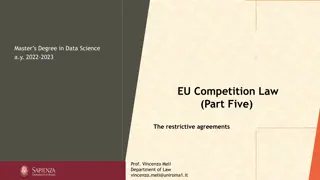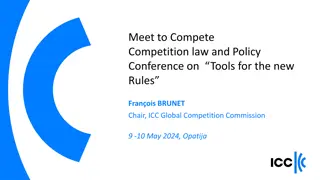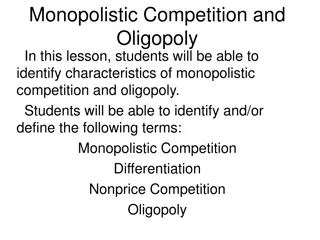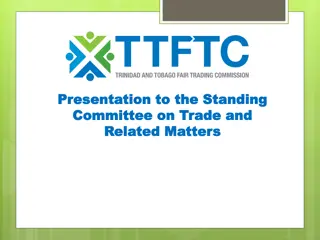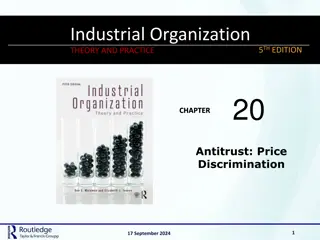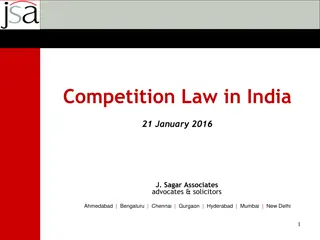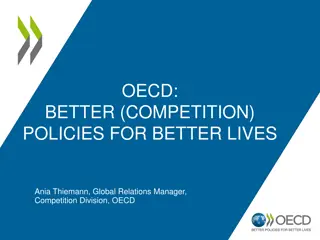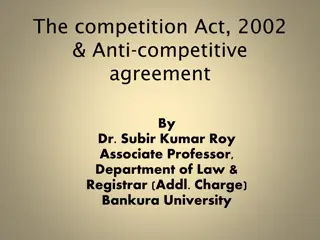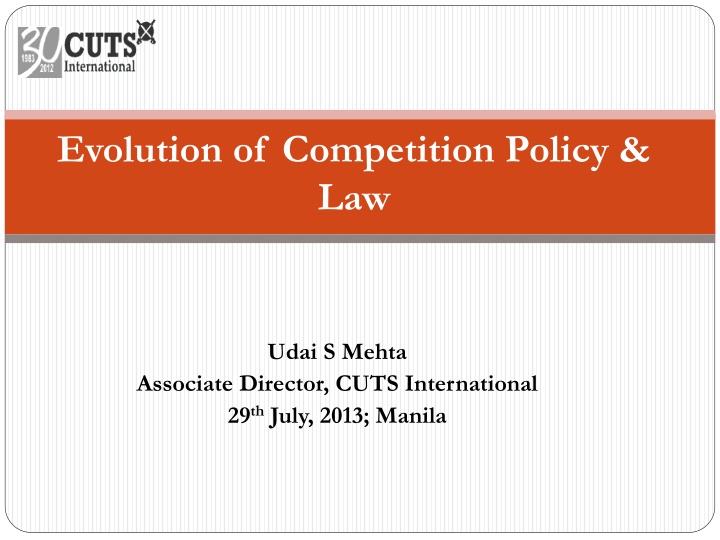
Evolution of Competition Policy and Law: A Comprehensive Overview
Explore the evolution, benefits, and challenges of competition policy and law worldwide, featuring insights from Udai S. Mehta, Associate Director at CUTS International. Learn about the historical background, the importance of competition, and the differences between competition policy and law. Discover how various countries have adopted competition laws over time, the inadequacy of competition law in addressing all market distortions, and the significance of competition policy in tackling government-induced distortions. Delve into the benefits of competition, including price reductions, innovations, and enhanced competitiveness in economies.
Download Presentation

Please find below an Image/Link to download the presentation.
The content on the website is provided AS IS for your information and personal use only. It may not be sold, licensed, or shared on other websites without obtaining consent from the author. If you encounter any issues during the download, it is possible that the publisher has removed the file from their server.
You are allowed to download the files provided on this website for personal or commercial use, subject to the condition that they are used lawfully. All files are the property of their respective owners.
The content on the website is provided AS IS for your information and personal use only. It may not be sold, licensed, or shared on other websites without obtaining consent from the author.
E N D
Presentation Transcript
Evolution of Competition Policy & Law Udai S Mehta Associate Director, CUTS International 29thJuly, 2013; Manila
Outline Introduction History Competition Policy vis- -vis Competition Law Benefits of Competition Evolution of CPL in India Scenario across the world Challenges in Developing Countries Conclusions 2
Introduction Why do we need competition? Impetus to promote competition Trade and economic liberalisation have aided competition in the market Anti-competitive practices negate the gains of liberalisation 3
History Canada first country to adopt the law in 1889 US was the second country to adopt the law in 1890 Finland s court judgment in 1837 on forest producers In France, the initial foundations of a competition law were laid in the Chapelier Law of 1791 In 1995, only about 35 countries with a competition law, today the number is nearly 120 countries and counting . 4
Is Competition Law Sufficient? No, because Cannot curb market distortions emanating from policies and practices of government (central as well as states) Examples: government procurement policy and rules, anti-dumping measures, public sector policy, etc Cannot facilitate ex-ante assessment of government policies to check market-distortionary elements Competition Policy: To address the policy-induced competition distortions Australia and Botswana is a classic case 5
Competition Policy vis--vis Competition Law FDI Policy Trade Policy Industrial Policy Disinvestment Policy Fiscal Policy IPR Policy Labour Policy Procurement Policy others
Benefits of Competition Excerpts from Select Studies Competition Policy led to large price reductions, innovations, and product development - -The Benefits from Competition: Some illustrative UK Cases, University of East Anglia, May 2004 Ensuring fair competition in the market is an essential ingredient for enhancement competitiveness in the economy - - EU White Paper on Competitiveness, 1994 and maintenance of Strong competition policy is not just a luxury to be enjoyed by rich countries, but a real necessity for those striving to create democratic market economies - -Joseph Stiglitz, Project Syndicate, August 2001 8
Evolution of Competition Policy and Law in India 1956: Public sector commanding heights of the mixed economy 1965: Monopolies & Restrictive Trade Practices Bill for the same was drafted 1967: Hazari committee 1969: Enactment of the MRTP Act 1991: Reforms Adopted: deregulation and liberalization 1995: Globalization spurred by establishment of WTO rampant, 9
Evolution of Competition Policy and Law in India 1999: Raghavan committee examines MRTP Act & proposes a new bill 2002: Competition Act adopted by Parliament 2003: Competition Commission of India established Full constitution of Commission and enforcement could not be taken up due to legal challenge leading to process of amendments 2007: Competition Amendment Act adopted 2011: Planning Commission Committee on Competition Policy http://www.mca.gov.in/Ministry/pdf/Draft_National_Competition_Policy.pdf 10
Evolution of Competition Policy and Law in India Issue of Competition in India has shifted from: Size to conduct Discouraging dominance to discouraging abuse of dominance Also, now includes: Combinations Strong component of advocacy 11
Scenario Across the World - Motivations Concentration in case of US, Canada, India, and Pakistan Adoption of trade and economic liberalisation Commitment under free trade agreements both WTO and PTAs Structural adjustments by African countries under pressure of MDBs Curbing state monopolies in case of former (Soviet bloc) and current (China and Vietnam) communist countries 12
Scenario Across the World Bad Case Practices Some bad case practices of diluting the law exist like Sri Lanka, Georgia Poor progress by some countries such as Nigeria, Ghana, Bangladesh, etc Public monopolies turning into private monopolies, various examples exist like Sri Lanka, Malawi, Senegal 13
Challenges for CAs in DCs Champions Political Will Interface problems: Sector Regulators Stakeholders awareness Resources & Capacity 14
Conclusions Political will and competition culture Effective competition law and policy benefits both individual consumers and business Need to speed up competition reforms (Competition Policy and Law matter in DCs ) Govt, CSOs and business dialogue crucial for healthy competition regime (advocacy) Competition is not a luxury reserved for the rich, it is a necessity for the poor Need for capacity building of civil society 15
Useful Resources Contours of a National Competition Policy: Development Perspective Harmonising Regulatory Conflicts Competition and Sector Regulation Interface Dimensions of Competition Policy and Law in emerging economies CUTS CCIER PUBLICATION DIGEST (2012) 16
Thank you usm@cuts.org www.cuts-international.org 17

